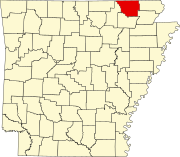Pocahontas, Arkansas
[4] Pocahontas has a number of historic buildings, including the Old Randolph County Courthouse built in 1871, the St. Mary's AME Church, and the Pocahontas Colored School built in 1918, the latter of which is now home to the Eddie Mae Herron Center.
Ransom S. Bettis is given the credit for being the first settlers on the land now called Pocahontas.
Dr. Bettis' daughter, Cinderella, married Thomas S. Drew, and lived on 800 acres where the town of Biggers now exists.
Randolph County is famous for many "firsts"; Arkansas' oldest town, Davidsonville, was established in 1815.
Randolph County encompasses the rolling hills of the Ozarks to the west and rich, flat farmland of the Mississippi Delta to the east.
Soybeans, rice, and other grains are the principal crops in the Delta region, while cattle ranching dominates the hill country.
During the early part of the Civil War, Camp Shaver, located in Pocahontas, was the headquarters for Confederate forces west of the Mississippi River.
The industrial base is diversified, with products such as shoes, large truck trailers, technical components for communications, picture frames, golf bags and luggage, tool boxes, wood products and more.
The other 10,407 residents of Randolph County live in rural areas and five incorporated communities - Maynard, Biggers, Reyno, Ravenden Springs and O'Kean.
Local legend holds that Pocahontas was named the county seat through an act of trickery.
The climate of the city is characterized by relatively high temperatures and evenly distributed precipitation throughout the year.
